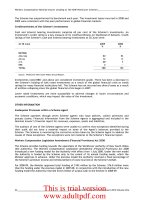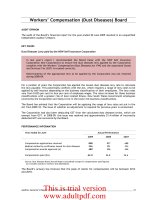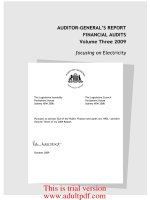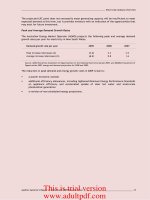AUDITOR-GENERAL’S REPORT FINANCIAL AUDITS Volume Three 2010_part5 docx
Bạn đang xem bản rút gọn của tài liệu. Xem và tải ngay bản đầy đủ của tài liệu tại đây (108.09 KB, 9 trang )
Auditor-General’s Report to Parliament 2010 Volume Three __________________________________________ 35
Compliance with the Fiscal Responsibility Act 2005
I recommend the Government seek amendments to the Fiscal Responsibility Act 2005 so
that it provides targets and priorities within the control of Government as part of the
five-yearly review.
The Fiscal Responsibility Act 2005 (FR Act) sets out principles for the financial management of the
State.
The purpose of the FR Act is to provide the framework for the conduct of New South Wales’
fiscal policy, with a view to maintaining financial results that are fiscally sustainable in the medium
and long term. The Treasury has provided commentary on its compliance with these principles in
the 2009-10 and 2010-11 Budget Papers.
The FR Act requires Government to manage financial risks and financial shocks in future periods
without having to introduce significant and economically or socially destabilising expenditure or
revenue adjustments in those future periods. What is considered consistent with fiscal
sustainability will vary depending on:
the strength and outlook for the economy
the structure of expenditure and revenue of the budget
the outlook for the State’s credit rating
demographic and social trends that will affect the budget, and
the nature of financial risks faced by the Government at any given time.
The FR Act requires the Government to pursue its policy objectives in accordance with the fiscal
targets detailed below.
My analysis indicates the Government may not meet the measures included in the FR Act largely
because they are significantly affected by variables outside their control. For example, the value of
superannuation liabilities is affected by movements in rates used to discount liabilities to present
value, over which the Government has no control. This makes it difficult to attribute accountability
when targets are not met, which reduces the overall effectiveness of the FR Act.
The Government should review the measures and related variables to identify and differentiate
between controllable and non-controllable events that will allow a reasonable analysis and
assessment of the policy decisions of Government.
The FR Act is due for a statutory five-yearly review during 2010-11, to assess whether:
the policy objectives of the FR Act remain valid, and
the terms of the FR Act remain appropriate for securing those objectives.
In the 2010-11 Budget Papers, The Treasury indicated a report on the outcomes will be tabled in
Parliament by June 2011.
This is trial version
www.adultpdf.com
Compliance with the Fiscal Responsibility Act 2005 ____________________________________________________
36 __________________________________________ Auditor-General’s Report to Parliament 2010 Volume Three
LONG TERM MEASURES
General Government Sector Net Financial Liabilities
General Government Sector net financial liabilities were $52.9 billion as at June 2010, equivalent
to approximately 12.6 per cent (12.0 per cent) of GSP. This is 5.1 per cent higher than the
7.5 per cent FR Act target for 30 June 2010. The long term target is six per cent or less by
30 June 2015.
6.0
8.0
10.0
12.0
14.0
2006
2007
2008
2009
2010
%
Net Financial Liabilities as a percentage of GSP
Net Financial Liabilities as a percentage of GSP
Target
General Government Sector net financial liabilities include all liabilities of the General Government
Sector less all financial assets (except for the Government’s equity in the public financing and
public trading enterprise sectors).
General Government Sector Net Debt
At 30 June 2010, the General Government Sector underlying net debt was 2.2 per cent ($9.4 billion)
of GSP compared to 2.0 per cent ($8.1 billion) of GSP as at June 2009. This is 1.4 per cent above
the FR Act target of 0.8 per cent of GSP.
The Treasury has indicated that due to the increased capital program, General Government Sector
net debt is estimated to be 2.7 per cent of GSP at 30 June 2011, but falling to 2.5 per cent of GSP
by June 2014.
-
0.5
1.0
1.5
2.0
2.5
2006
2007
2008
2009
2010
%
Net Debt as a percentage of GSP
Net Debt as a percentage of GSP
Target
This is trial version
www.adultpdf.com
___________________________________________________ Compliance with the Fiscal Responsibility Act 2005
Auditor-General’s Report to Parliament 2010 Volume Three __________________________________________ 37
General Government Sector net debt is the sum of all deposits held by, advances received by and
borrowings made by the General Government Sector less the sum of cash and deposits held by,
advances paid and investments, loans and placements made by the General Government Sector. It
excludes financial assets that are allocated to fund other liabilities through legislation or contract.
Total State Sector Unfunded Superannuation Liability
Total State Sector unfunded superannuation liabilities were $34.5 billion at June 2010, an increase
of $3.5 billion from June 2009. The FR Act target is to eliminate Total State Sector unfunded
superannuation liabilities by 30 June 2030.
-
5.0
10.0
15.0
20.0
25.0
30.0
35.0
40.0
2006
2007
2008
2009
2010
$b
Total State Sector Unfunded Superannuation Liability
Unfunded Superannuation Liabilities
Linear representation of targeted reduction over time
The increase in 2009-10 unfunded superannuation liabilities was primarily due to a reduction in the
discount rate used by the actuary in calculating the accrued liabilities.
At the time the 2010-11 Budget was presented to Parliament, The Treasury believed the fiscal
target would be met in the future:
‘Employer Contributions are being assessed periodically to ensure full funding by
30 June 2030.
While the [Global Financial Crisis] GFC has slowed progress, the downward trend is
continuing. Proceeds of the Lotteries transaction and a new funding plan will ensure full
funding by 2030. Total State net unfunded superannuation liabilities are estimated to be
$28.6 billion at 30 June 2010 and $28.7 billion at 30 June 2014.’
This is trial version
www.adultpdf.com
This is trial version
www.adultpdf.com
Auditor-General’s Report to Parliament 2010 Volume Three __________________________________________ 39
Agency Amalgamations
In my Volume Two 2010 Report to Parliament I raised the following concerns:
governance arrangements are not yet fully operational
financial reporting requirements and related processes have not been finalised by some
newly formed departments
uncertainty exists as to whether further legislative changes will occur that will impact
financial reporting at 30 June 2010.
Since that time, I have surveyed agencies’ compliance with The Treasury’s Internal Audit and Risk
Management Policy and the results of the survey will be reported in a later volume. Financial
reporting by amalgamated agencies have not delayed the preparation of the Total State Sector
Accounts. At the time of writing this report, the audits of the financial statements of these
departments are in progress.
GOVERNANCE ARRANGEMENTS
I recommend The Treasury and Department of Premier and Cabinet clarify the intention of
TPP 09-05 Internal Audit and Risk Management Policy for the New South Wales Public
Sector. If the intention is for authorities within the same ‘cluster’ to use the Audit and Risk
Committee of another authority, they should seek amendments to section 11(2) of the
Public Finance and Audit Act 1983 and the TPP 09-05 to clearly authorise this.
Following the July 2009 amalgamation order, some new departments have proposed and established
a single audit committee for the new department and invited other authorities within their clusters
to use their audit committee. In some cases, authorities have accepted this invitation. However,
some authorities share my concern as to the legality of such arrangements under the Public Finance
and Audit Act 1983 (PF&A Act) and TPP 09-05.
In April 2010, two authorities sought advice from the New South Wales Crown Solicitor as to
whether there was an obligation for the head of an authority to establish an internal audit
organisation [audit committee] under Section 11(2) of the PF&A Act.
The Crown Solicitor responded that:
‘On balance, I considered the required internal audit organisation was one which must be
established within the authority.’
In May 2010, further advice was sought by these authorities to clarify whether they could join or
use the audit committee of the new department.
The Crown Solicitor responded that:
‘Nor do I think that Section 11(2) [PF&A Act] and TPP 09-05 contemplate that an Audit and
Risk Committee of an authority is also to be the Audit and Risk Committee for another
authority, even if the latter is in the same ‘cluster’.
If it is intended that an internal audit organisation required by s11(2), PF&A Act, should be
composed in accordance with TPP 09-05 and should also be able to be the Audit and Risk
Committee for other authorities in the same ‘cluster’ as the authority whose Head
establishes it, s.11 of the PF&A Act and TPP 09-05 should be amended appropriately to
clearly authorise this.’
This is trial version
www.adultpdf.com
Agency Amalgamations ____________________________________________________________________________
40 __________________________________________ Auditor-General’s Report to Parliament 2010 Volume Three
FINANCIAL REPORTING REQUIREMENTS
The amalgamation order resulted in the following financial reporting entities:
New Reporting Entity Audit Status
(at 21 October 2010)
Primarily made up of the previous:
Department of Premier
and Cabinet
Independent Auditor’s Report
signed on 20 October
Department of Premier and Cabinet
Ministry for Police
Department of Local Government
Communities NSW
Independent Auditor’s Report
signed on 21 October
Department of Arts, Sport and Recreation
Office for Children
Department of Justice
and Attorney General
Independent Auditor’s Report
signed on 20 October
Attorney-General’s Department
Department of Corrective Services
Department of Human
Services
Independent Auditor’s Opinion
signed on 20 October
Housing NSW
Department of Juvenile Justice
Department of Ageing, Disability and Home
Care Services
Department of Community Services
Department of Aboriginal Affairs
Department of Industry
and Investment
Independent Auditor’s Opinion
expected to be issued by 29
October
Department of State and Regional
Development
Department of Primary Industries
Components of
Department of Water and
Energy
Department of
Environment, Climate
Change and Water
Independent Auditor’s Opinion
signed on 1 October
Department of Environment and Climate
Change
Components of Department of Water and
Energy
Legislation was also enacted on 1 July 2010 creating Transport NSW.
I recommend The Treasury and Department of Premier and Cabinet take a lead role in
monitoring, supporting and reporting on the implementation of common financial reporting
and support systems within the amalgamated departments.
During my audits of amalgamated agencies I identified:
some agencies are yet to make significant progress on implementing common financial
reporting and support systems to leverage synergies expected from the amalgamations
additional costs associated with the amalgamations are not readily identifiable
systems have not been put in place to capture and report cost savings associated with the
initiative.
This is trial version
www.adultpdf.com
Auditor-General’s Report to Parliament 2010 Volume Three __________________________________________ 41
Appendix A: Legal Opinions Provided by the Attorney
General or Crown Solicitor
I am required by section 52(2) of the Public Finance and Audit Act 1983 to publish any requests for
a legal opinion submitted to the Attorney General or the Crown Solicitor under section 33 of the
PF&A Act. I am also required to publish their responses.
There was only one such legal opinion since my last report contained in Volume Four 2009, released
on 29 October 2009. It relates to the application of Corporations Act 2001 to companies reporting
under the PF&A Act. I have also included the supplementary advice from the Crown Solicitor
regarding the same matter.
This is trial version
www.adultpdf.com
Appendix A: Legal Opinions Provided by the Attorney General or Crown Solicitor __________________________
42 __________________________________________ Auditor-General’s Report to Parliament 2010 Volume Three
Original PDF - D0929864/D0929865 - Application of the Corporations Act (Cwlth) 2001
to companies reporting under the PF&A Act – 9 July 2009
S Fryer
9275 7218
A005025
Mr. I Knight
Crown Solicitor
GPO Box 25
Sydney NSW 2001
9 July 2009
Dear Mr. Knight
Application of the Corporations Act (Cwlth) 2001
To companies reporting under the PF&A Act
The Public Finance and Audit Act 1983 (the PF&A Act) requires certain companies incorporated under the
Corporations Act (Cwith) 2001 (the Corps Act) to prepare financial reports and have them audited by the
Auditor-General, I seek your advice on whether these PF&A Act requirements also create an obligation for all
such companies to prepare their accounts and have them audited in accordance with the Corps Act.
Under the Corps Act, a “small” proprietary limited company is not required to prepare accounts and have
them audited unless requested to do so by a shareholder direction under s.293, or by an ASIC direction under
s.294 of the Corps Act.
In situations where a “small” proprietary Limited company has not received a specific written direction from
the shareholders of the company, I am unsure about the application of the Corps Act to the financial report
prepared and audited under the PF&A Act. I believe the Auditor-General is not required to conduct the audit
in accordance with the Corps Act. Accordingly the Auditor- General is not required to report breaches of the
Corps Act to ASIC under s.311 or form an opinion in accordance with s.307 of the Act. I understand that the
Auditor-General’s reporting obligations only arise from the provisions of the PF&A Act, and the requirements
prescribed within the Australian Auditing Standards.
Section 4A of the PF&A Act provides for regulations to be made regarding the relationship with the
Corporations Legislation. While such regulations would be relevant to my question, I am not aware that any
exist.
We would like the opportunity to discuss this matter before you commence preparing your advice. When
convenient, please call Steve Fryer (9275 7218) who is the relevant contact person in my office.
Yours sincerely
A T Whitfield
Deputy Auditor-General
This is trial version
www.adultpdf.com
__________________________ Appendix A: Legal Opinions Provided by the Attorney General or Crown Solicitor
Auditor-General’s Report to Parliament 2010 Volume Three __________________________________________ 43
CROWN SOLICITOR’S OFFICE
NEW SOUTH WALES
Facsimile
To: Anthony Whitfield
Deputy Auditor-General
Audit Office of NSW
Your ref: Steven Fryer
Fax: (02) 9275 7179
Date: 30 September 2009
From: I V Knight Crown Solicitor
Tel: (02) 9224-5235
Fax: (02) 9224-5244
My ref: TB 200902052
Email: ctownsoIagd.nswgov.au
Application of Corporations Act to companies reporting under Public Finance, and Audit Act
Advice follows.
Confidentiality Notice: This facsimile transmission (including any documents accompanying this facsimile
transmission) may contain information which is confidential and/or privileged. Therefore it you are not the
intended recipient of this facsimile transmission, any dissemination, copying or action taken in reliance on
the contents of this facsimile transmission is strictly prohibited If you have received this facsimile
transmission in term, please notify the sender on the above telephone number,
CROWN SOLICITOR’S OFFICE ABN 50132 005 54.4 • 60-70 Elizabeth Street Sydney NSW 2000 * GPO Box 25
Sydney 2001 • OX 19 5ydney Telephone 02 9224 5000 • Fax 02 9224 5011
This is trial version
www.adultpdf.com









